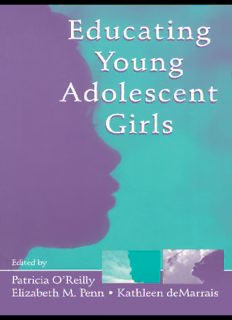
Educating Young Adolescent Girls PDF
Preview Educating Young Adolescent Girls
EDUCATING YOUNG ADOLESCENT GIRLS EDUCATING YOUNG ADOLESCENT GIRLS Edited by Patricia O’Reilly University of Cincinnati Elizabeth M.Penn Thomas More College Kathleen deMarrais University of Georgia LAWRENCE ERLBAUM ASSOCIATES, PUBLISHERS Mahwah, New Jersey London This edition published in the Taylor & Francis e-Library, 2008. “To purchase your own copy of this or any of Taylor & Francis or Routledge’s collection of thousands of eBooks please go to http://www.ebookstore.tandf.co.uk/.” Copyright © 2001 by Lawrence Erlbaum Associates, Inc. All rights reserved. No part of the book may be reproduced in any form, by photostat, microfilm, retrieval system, or any other means, without the prior written permission of the publisher. Lawrence Erlbaum Associates, Inc., Publishers 10 Industrial Avenue Mahwah, New Jersey 07430 Cover design by Kathryn Houghtaling Lacey Library of Congress Cataloging-in-Publication Data Educating young adolescent girls/edited by Patricia O’Reilly, Elizabeth M.Penn, Kathleen deMarrais p. cm. Includes bibliographical references and index. ISBN 0-8058-3259-9 (pbk.: alk. paper) 1. Teenage girls—Education (Middle school). I. O’Reilly, Patricia (Frances Patricia). II. Penn, Elizabeth Marie. III. DeMarrais, Kathleen. LC1481.E39 2001 373.1822–dc21 00–067761 CIP ISBN 1-4106-0073-4 Master e-book ISBN For Julia, Shannon, and Annamarie, who helped us understand why this book was necessary. —P.O.K. —E.M.P. Contents Introduction 1 Kathleen deMarrais Key Concepts Chart 5 PART I: GROWTH AND DEVELOPMENT 9 1 Learning to Be a Girl 11 Patricia O’Reilly 2 “Tell Them We’re Girls”: The Invisibility of Girls With Disabilities 29 Anne M.Bauer 3 Educating Young Adolescent Girls About Lesbian, Bisexual, and Gay 47 Issues Kathleen Schmidt Prezbindowski and Amy K.Prezbindowski PART II: TEACHING AND LEARNING 83 4 A Delicate Balance: How Teachers Can Support Middle School Girls’ 85 Confidence and Competence Sumru Erkut, Fern Marx, and Jacqueline P.Fields 5 When Bodies Matter: Teaching Adolescents About Community, 105 Critical Consciousness, and Identity Through Movement Kathleen Farber 6 Little Warrior Sistas: Reading Their Worlds for Liberation 125 P.Twyman Hoff, Nina Eddings, and Elizabeth Peavy 7 Developing Mathematical Voice: Women Reflecting on the 149 Adolescent Years Diana Brandy Erchick vii viii CONTENTS 8 Technically Speaking: Girls and Computers 173 Cynthia Cone 9 Daily Acts of Ordinary Courage: Gender-Equitable Practice in the 191 Social Studies Classroom Linda S.Levstik 10 Understanding Relationship and Career Concerns of Middle School 215 Girls Mei Tang and Ellen P.Cook 233 11 Class Action: Teaching for Equity Elizabeth M.Penn Glossary 249 Suggested Resources and Readings 257 Author Index 265 Subject Index 273 Introduction Kathleen deMarrais MEET THE AUTHOR Kathleen deMarrais is a professor and the coordinator of the Qualitative Inquiry Program at the University of Georgia. She is a teacher educator and has worked for years with in-service and preservice teachers in literacy education and in supporting their action research efforts. Prior to her work in higher education, Kathleen was a special education teacher (LD/BD) for 14 years. Her research focuses on school equity issues, particularly as related to social class, gender, and ethnicity. Earlier research focused on the experiences of rural and urban Appalachian students in schools. Currently, she is studying teachers’ experiences of anger in classroom and school settings. She is co- author with Margaret D.LeCompte of The Way Schools Work: A Sociological Analysis of Education (3rd ed.) and editor of Inside Stories: Qualitative Research Reflections. Young adolescent girls come to schools in a variety of shapes and sizes, racial and sexual identities, with varying abilities, interests, and talents. They come from families across the spectrum of social class backgrounds from poor to wealthy. They are our daughters and granddaughters, sisters and nieces, students and friends. Because we care about them, we want their schooling experiences to be interesting, authentic, and safe. We want to challenge their minds and bodies to stay alert to an inviting, diverse, and sometimes unjust world. What do we know about these girls? Plenty. We know about them from research as well as from our own experiences as girls and women. Since the beginning of the second feminist movement in the 1960s, we have built a rich fund of knowledge about the experiences of girls and women in and out of schools. We know about ways our cultural forms impact their values, beliefs, and behaviors. We certainly have not exhausted the possibilities for research in this 1
Description: